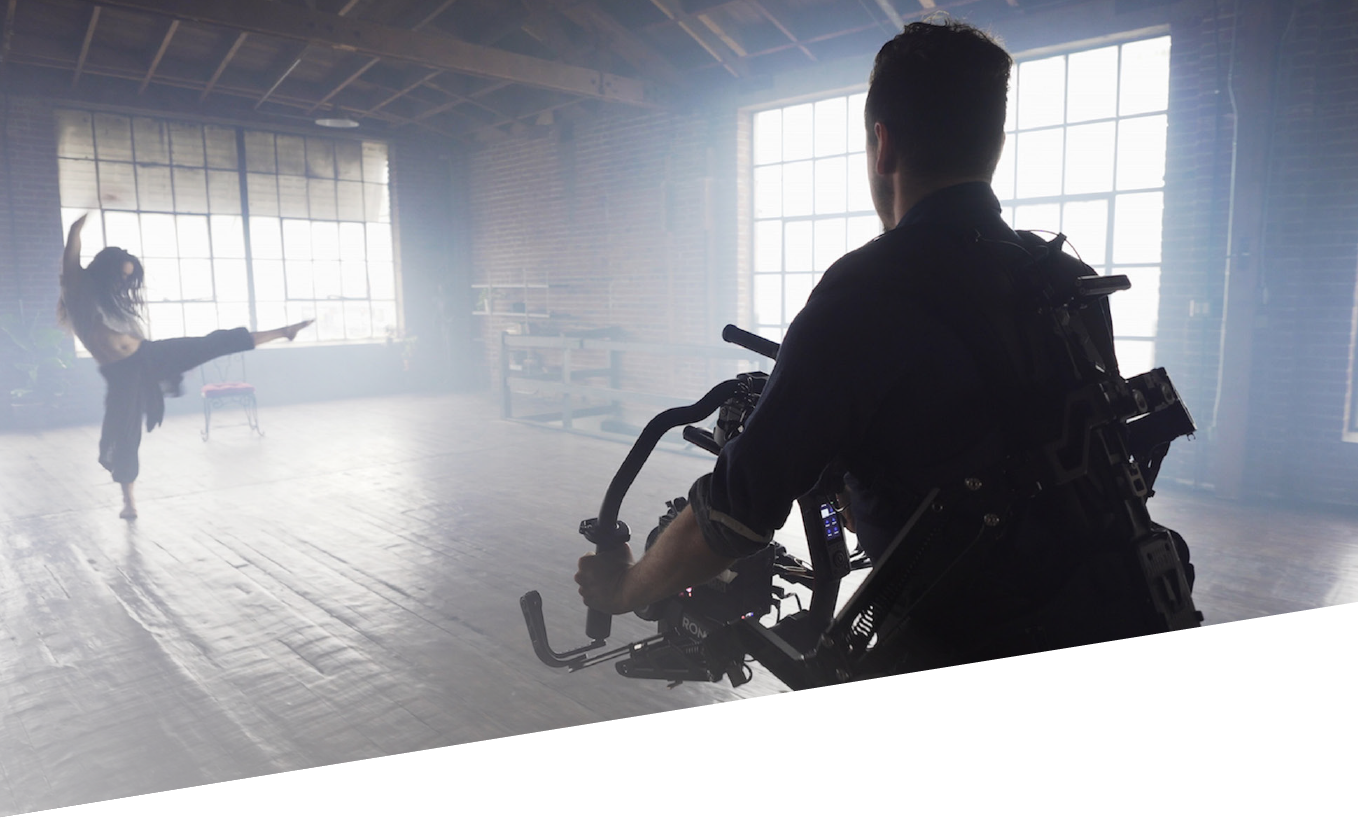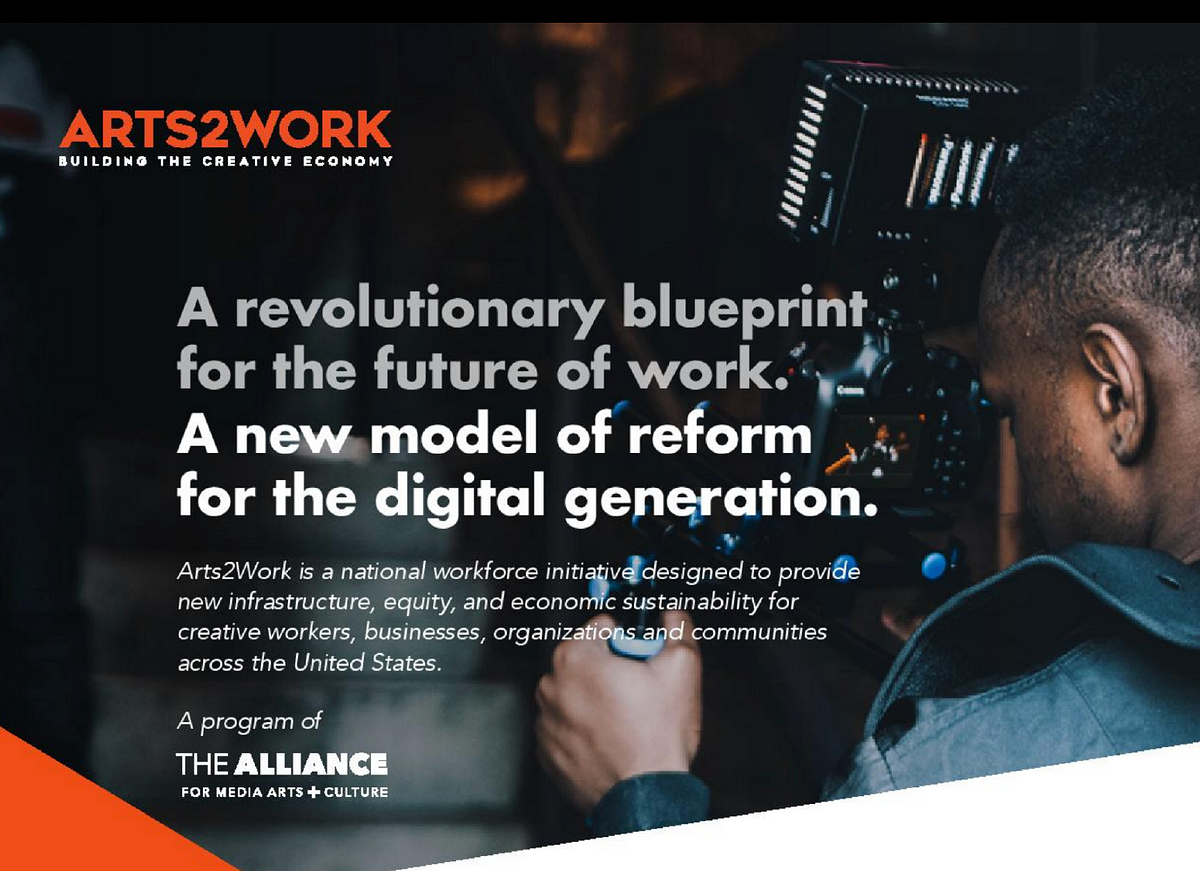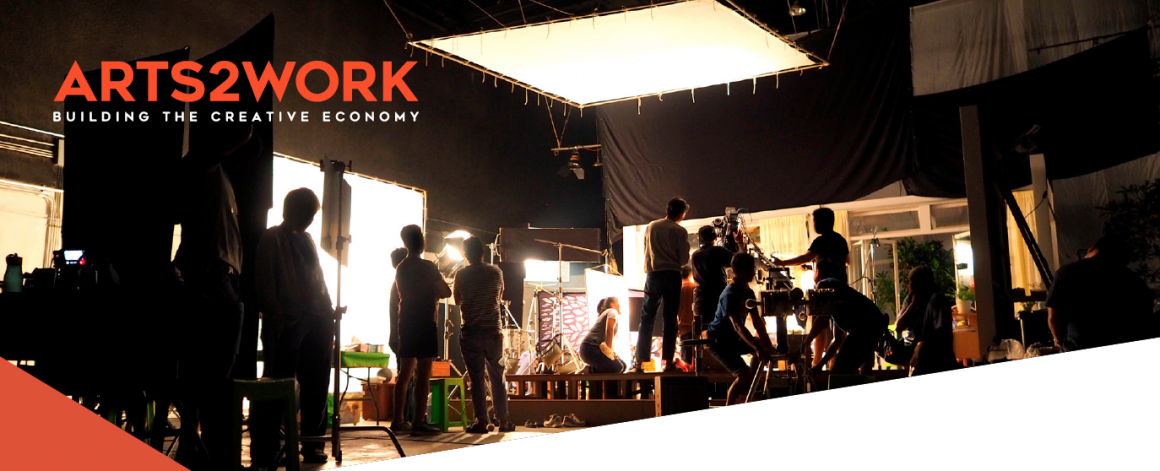by Wendy Levy
Arts2Work is a new creative workforce development initiative sponsored by The Alliance for Media Arts + Culture that includes the very first federally-registered National Apprenticeship Program in Media Arts and Creative Technologies. It’s a jobs program for storytellers; with a vision of transforming the creative economy, building a world where #oscarssowhite is a thing of the past, and where the power of the #metoo movement has led to a new generation of women leaders in media. We believe that if we want to change the world, we’ve got to change the stories first.

When The Alliance for Media Arts + Culture decided to get into the Apprenticeship business, we created Arts2Work on behalf of creative media artists across the country struggling to find sustainable, reliable, rewarding, living wage jobs. The job market is daunting for filmmakers, media producers, editors and other creatives emerging from high school, college programs and film schools alike, and there is little infrastructure to support accessible pathways for in-demand jobs in the industry. Required skills evolve daily with emerging technologies, you need an impressive reel of powerful stories and visuals just to get your foot in the door — and you can’t build the reel you need without professional experience. Internships are sometimes available for students enrolled in a program — but only the ones who can afford to work for free can take advantage of those opportunities. And all this is exponentially more challenging for producers from racial and ethnic minority groups. Check the research; if you don’t look like the CEO, your chances of getting hired are slim to none.
After our first phone call to the US Department of Labor, we knew that we were embarking on a paradigm-shifting journey. There were no federally-registered Apprenticeship programs in our sector, and therefore no possibility for creative workers to participate in the federal workforce development system. This was our opportunity. From that moment, we started acting like a National Program Sponsor on behalf of our thousands of members who deserve the same leg up as plumbers, electricians, pipefitters, and elevator installers, who can get paid to learn on the job, receive hours of classroom and online training, and whose employers can receive subsidies to defray the cost of the apprenticeship. We knew we had to focus on jobs and make the business case for Apprenticeship, showing US media companies how their counterparts have leveraged apprenticeship for a positive return on investment. But this is not just about creating a source of skilled, innovative workers in a sector long known for entrenched practices that deny opportunities to “outsiders.” Embedded in the soul of Arts2Work is a set of ideas and practices designed to bend the arc of #oscarssowhite and the #metoo movement towards a more just and equitable ecosystem for all.
What we did not realize when we made that first call to the US Department of Labor, was how we’d have to upend multiple systems at once: the system that excludes creative careers from federal/state workforce development investments; that prevents artists of color, low-income workers, women, youth, disabled and veteran’s communities from accessing and advancing in media careers; that reserves internships for the privileged; and the system that persistently devalues or ignores the creative and economic contributions of artists in local, regional and national economic development initiatives. Attempting to align the forces where this kind of change is possible is the “radical” part of our plan. As Toni Morrison said, “This is precisely the time when artists go to work. There is no time for despair, no place for self-pity, no need for silence, no room for fear.”

This work did not come out of the blue for The Alliance; we were designed for it. The organization has been advocating for the field since 1980 when it was founded by an eclectic group of media arts organization leaders who realized they could strengthen their social and cultural impact by working as a united force. From day one, The Alliance worked to raise the profile and influence of the media arts on behalf of a growing and changing membership. Today, we are a network of networks: local, regional and national media nonprofits, international NGOs and strategic business partners from all sectors, as well as individual media practitioners and educators across disciplines. In a time when the demand for digital content is higher than ever, emerging media technologies are evolving at light speed, and diverse audiences are demanding stories by, for and about their own lives — there is a crisis of access to meaningful, sustainable work and a dearth of opportunity for creative startups run by women, people of color, and others outside the venture capital power structures.
Whether producing, shooting or editing for Hollywood movies and television, independent film, documentary and journalism, sports, games and interactive, radio, health care or other types of branded content — the roadblocks that exist to jobs and opportunities for advancement is documented. You can read the research. It is especially challenging for minority and low-income creatives who may not “know people” in the industry or have the resources for a college or other post-secondary film program; for young people who may have mad talent but little exposure to field-specific job readiness training; for women in male-dominated industry sectors (in the top-grossing films of 2017, women represented 2% of the cinematographers, 8% of the directors, 14% of the editors, etc.), and the list goes on. For artists of color, explicit racism and implicit bias is an everyday occurrence; we live in a world that persistently appropriates black culture and completely devalues black imagination. As Ava DuVernay has said, “We sit on top of a broken system. I’m an anomaly. Ryan Coogler is an anomaly, [Moonlight’s] Barry Jenkins is an anomaly, [Mudbound’s] Dee Rees is an anomaly. When you can name us all on two hands, that’s not change.”
_________________
ARTS2WORK IS A BIG IDEA BASED ON A LITTLE-KNOWN FACT.
THE FACT: IN 2015, THE ARTS SECTOR IN THE UNITED STATES CONTRIBUTED $166.3 BILLION IN ECONOMIC ACTIVITY, SUPPORTED 4.6 MILLION JOBS AND GENERATED $27.5 BILLION IN REVENUE TO LOCAL, STATE AND FEDERAL GOVERNMENTS.
THE BIG IDEA: IT IS TIME TO RECOGNIZE AND EXPAND THE HUGE CONTRIBUTIONS OF WORKING ARTISTS TO THE U.S. ECONOMY THROUGH A NATIONAL SYSTEM OF INVESTMENT IN CREATIVE PEOPLE, BUSINESSES, AND NONPROFIT ORGANIZATIONS.
_________________
So how do we transform the broken system? How do we take the existing model of Registered Apprenticeship, customize it to fit the needs of creative employers and workers, and actually create the conditions where more people have the opportunity to advance and thrive in the industry? This is our big idea. We are looking to create pathways out of poverty through access to on-the-job training for living wage creative careers. We are working to replace a culture of disposable interns doing meaningless tasks, with a culture of apprenticeship where workers and employers are accountable to one another in an environment of respect and inclusion. We want more voices from the margins moving to the center, more creative talent being acknowledged and utilized, more independent producers thriving economically and investing in their neighborhoods, more companies able to expand and keep current with new technology. We want it all.
The interconnectedness of economic development, poverty alleviation, age, race and gender equity, and diversity that includes veterans, LGBTQ folks and people with disabilities — this is the DNA upon which Arts2Work is based. We are working towards a new reality where equity and diversity are not a chore, not a box to be checked. The far-ranging cultural perspectives that diverse creative workers bring, and the positive impact we have on the bottom lines — this is the new status quo. We want every movie produced, every commercial made, every corporate industrial, every virtual reality project, every television series, every video game launched, every interactive news story — to have paid apprentices working side-by-side with mentors, learning-on-the-job, contributing to projects, adding tangible, measurable value to the workplace, to their communities, to the economy, and to our collective culture. This model goes way beyond what is offered by traditional training programs. As award-winning production designer (and Arts2Work advisor) Wynn Thomas has said to us more than once, “training without a job is a broken promise.”
In Training for Success, a 2013 report from the Center for American Progress, a number of the barriers to the adoption of apprenticeships in the United States are identified, along with potential interventions to mitigate those challenges:
- •Poor understanding of apprenticeships
- • Limited occupational and gender reach
- • Costs to businesses• Disjointed administration• Lack of research• Inconsistent certification standards• Lack of coordination with the education system
According to the report, to dramatically increase the number of apprentices in the United States will require “boosting public awareness, expanding into nontraditional occupations, mitigating the costs to sponsors, enhancing research and certification standards, and improving coordination with education systems.” Arts2Work has become a national Program Sponsor committed to Apprenticeship development and expansion — building a new, culturally-responsive model relevant for creative media careers, journalism and related professions.

An Arts2Work Apprenticeship is a one-year, learn-on-the-job program, including one-on-one mentorship, project-based learning, technical certification and 150 hours of professional classroom instruction (in person and/or online). We can customize training plans with each participating employer, offer transferable college credit in many cases, and will soon be adding additional job categories like Digital Archivist, Cinematographer, and Game Designer, in addition to Producer and Editor. Apprentices need a minimum experience level to be ready for Apprenticeship we will work with regional partners to launch pre-Apprenticeship programs that enhance technical skills, offer entry-level professional certification, build collaborative relationships and orient trainees to the reality of work in creative media and emerging technologies.

In 2019, we will launch nationally in partnership with some of the first Arts2Work states, the first Arts2Work cities, the first Arts2Work certified training centers, the first Arts2Work employers and mentors, and the first Arts2Work apprentices. With adequate funding in place, we will also launch pre-apprenticeship programs to prepare young creatives, train and support mentors, and provide technical assistance to employers so they can provide the best possible environment where their new apprentices, and their senior staff, can advance and thrive.
The Alliance has received generous funding to support Arts2Work development from MacArthur Foundation, Wyncote Foundation and Adobe, and we look forward to building a portfolio of public/private investment moving forward. We are particularly grateful to these foundations for their support of the vision of Arts2Work. Traditional workforce development funders do not work with creative professions as a practice, and arts funders are rarely approached about federal workforce development initiatives. We believe that the potential for a paradigm shift is real. With private, federal and state investments in the Arts2Work registered Apprenticeship model, engagement from a diverse group of visionary employers in the program and the Arts2Work Accelerator Fund — we can go back to Ava DuVernay, and all the hopeful artists, mediamakers and producers of the future — with a new narrative of change.

In January 2018, right after we received our federal approval for Arts2Work, I was lucky to be at the Sundance Film Festival with Christina Orticke, the visionary Operations Director for Art2Work. After announcing Arts2Work during a panel at the Filmmaker Lodge, a young man named Ajani Amiri Thomas came up and introduced himself to us. Ajani was a junior at Howard University, a film/television major with mad skills in writing, animation, and cinematography — and big ideas for his future. He said, “I think you’ve just changed my life.”
That is the whole idea.
***
Arts2Work is coming soon. Get involved with us to make Arts2Work a reality. wendy@thealliance.media, arts2work@thealliance.media
BACKGROUND Arts2Work began as the Creative Workforce Development Initiative in 2015 at The Alliance for Media Arts +Culture. Envisioned and designed by Alliance Executive Director Wendy Levy, it came about just a year after President Obama signed the new Workforce Innovation and Opportunity Act (WIOA) into law. It was a pragmatic response to the real challenges faced during many years of serving struggling artists and arts organizations, and catalyzed by series of field convenings and reports dealing with the lack of career sustainability for independent filmmakers. Levy herself was a waitress for 25 years as she built her career as a creative professional. Even after going back to school for an MFA in Cinema, and her first short film premiered at Sundance, Levy found there were no fulltime jobs available, no viable means of support for a feature film project, a dearth of fulltime teaching positions, and few grants for which she qualified. After relinquishing a filmmaking career to indulge her true calling as a futurist and passionate advocate for artists and communities, Levy began leading nonprofits and consulting forfoundations and creative institutions to devise powerful and innovative public programs like The Producers Institute for New Media Technologies and the Sundance/Skoll Stories of Change Program. After developing Arts2Work for a year, Levy partnered with Raben_Impact, a project of The Raben Group, and Consultant Elspeth Revere, former Vice President of the MacArthur Foundation, as strategists and policy advisors. In 2017, Christina Orticke joined the Alliance consulting team, bringing over 25 years of experience working with large international public and privatecorporations, start-ups, minority-owned/women-owned enterprises, and nonprofit organizations. Orticke will oversee administration and end-to-end operations of the national Arts2Work program. http://www.thealliance.media/Arts2Work

